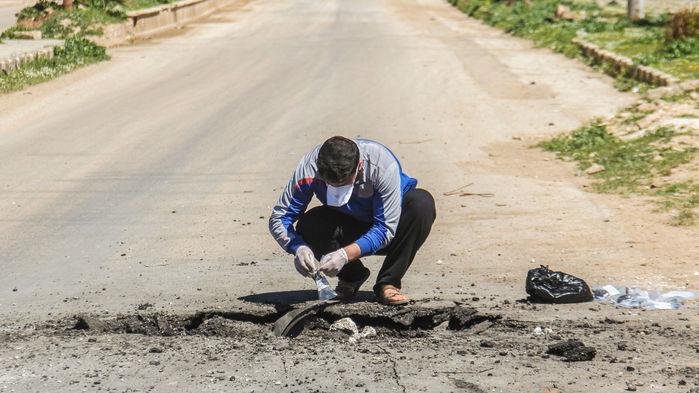Study Questions Report of Syrian Govt’s Use of Nerve Gas

Image for representational use only.Image Courtesy : Science.
In 2017, US president Donald Trump had fired 59 cruise missiles at a Syrian air base. This was in reaction to the chemical attack in the Syrian town of Khan Shaykhun on April 4. The US intelligence agencies claimed that it had definitive evidence of Syrian government doing the chemical attack by dropping a bomb filled with the nerve gas ‘sarin’. Six months later, a Joint Investigation Mechanism (JIM) of the United Nations and the Organization for the Prohibition of Chemical Weapons echoed what the US investigation agencies declared. Going by their theory, Khan Shaykhun is a town that was captured by the rebels against Al Assad, the Syrian president, and as a measure to uproot the rebels, the Al Assad government had resorted to the sarin attack.
Now, a manuscript that analysed the 2017 attack and questioned the conclusion that it was the Syrian government that carried out the chemical attack has given rise to a heated dispute among the scientists. The manuscript was supposed to be published in the prestigious journal Science and Global Security (SGS), published from the Princeton University. But, the publication has been suspended, as has been reported by Science. The suspension has come under fierce criticism and warnings that the paper, if published, would help Al Assad and also the Russian government. Notably, both of them had denied involvement of Syria in the incident.
Professor emeritus at the Massachusetts Institute of Technology (MIT) and a respected expert on missile defense and nuclear weapons, Theodor Postol, is the lead author of the paper. Postol has written on various media channels in the form of blog and posts reiterating what his research revealed. He said repeatedly in these writings that Syrian regime is not at all responsible for the Khan Shaykhun chemical attack. Gregory Koblentz, on the other hand, criticised Postol that he has disregarded the evidences and he also has a pro-Assad agenda. Koblentz is a biological and chemical weapon expert at the George Mason University in Fairfax, Virginia. Koblentz reportedly wrote several times to the editors of the journal urging not to publish the paper.
Another scientist, Goong Chen of the Texas A&M University also conducted a study about the same incident. Chen is an applied mathematician who modeled the happenings in Syria and also contacted Postol and others to get engaged in the research. Chen started his work after he came to know about Postol’s previous work on the Syrian conflict. The collaborative effort of Goong Chen, Theodor Postol and others resulted the disputed manuscript now facing suspension by SGS. The manuscript focused on the small-impact crater, which was believed to be the site of sarin release.
The JIM’s conclusion that the hole, about half a metre deep, was the result of a bomb dropped from an airplane and it had implicated the Syrian government. In doing so, they had taken into consideration the photos, satellite images, munition remnants and witness interviews. But, Chen and Postol’s models had something else to suggest. Their models revealed that the hole could have been formed by a 122 millimeter artillery rocket armed with a small explosive warhead. Noteworthy is the fact that Syrian government does not have a monopoly over such weaponry.
Bellingcat, the investigative website, published a detailed account of the paper on September 13. The Bellingcat critique of the manuscript says that the crater, as modeled in it, does not match the one in Khan Shaykhun. It also said that the model does not look like a real world crater formed by a 122 millimeter artillery rocket.
Postol, however, has rejected the Bellingcat version. About the website’s founder and the UK journalist Eliot Higgins, Postol quoted to have said to Science that he “has no scientific training, knows no science, and is not interested in learning any science. He has looked at other evidence as well and now believes there was no sarin attack at all, but that local people made it look like one occurred. The investigation reports were faked to justify the U.S. missile attack”.
Earlier in September, SGS editorial board had said that they have planned to publish the paper with the required editing. On the Journal’s website, it was written: “We understand that while no analysis in this field can be completely dissociated from its political context, the scientific community has well-established practices for dealing with this challenge.”
But, on September 24, the journal backtracked. The journal website read that an independent and internal review of the paper has “identified a number of issues with the peer-review and revision process. As a result, the editors have decided to withhold the publication of this article to examine whether the editors can rectify the problems that we identified.”
With this argument the journal has withheld the publication of the paper and subjected it to further rectification. However, Postol said that he is confident that SGS will eventually publish the paper, while Goong Chen said that he was stunned by the move.
Get the latest reports & analysis with people's perspective on Protests, movements & deep analytical videos, discussions of the current affairs in your Telegram app. Subscribe to NewsClick's Telegram channel & get Real-Time updates on stories, as they get published on our website.














